Patterns and Processes of Arthropod Community Succession after a Fire Extended Abstract Introduction
advertisement
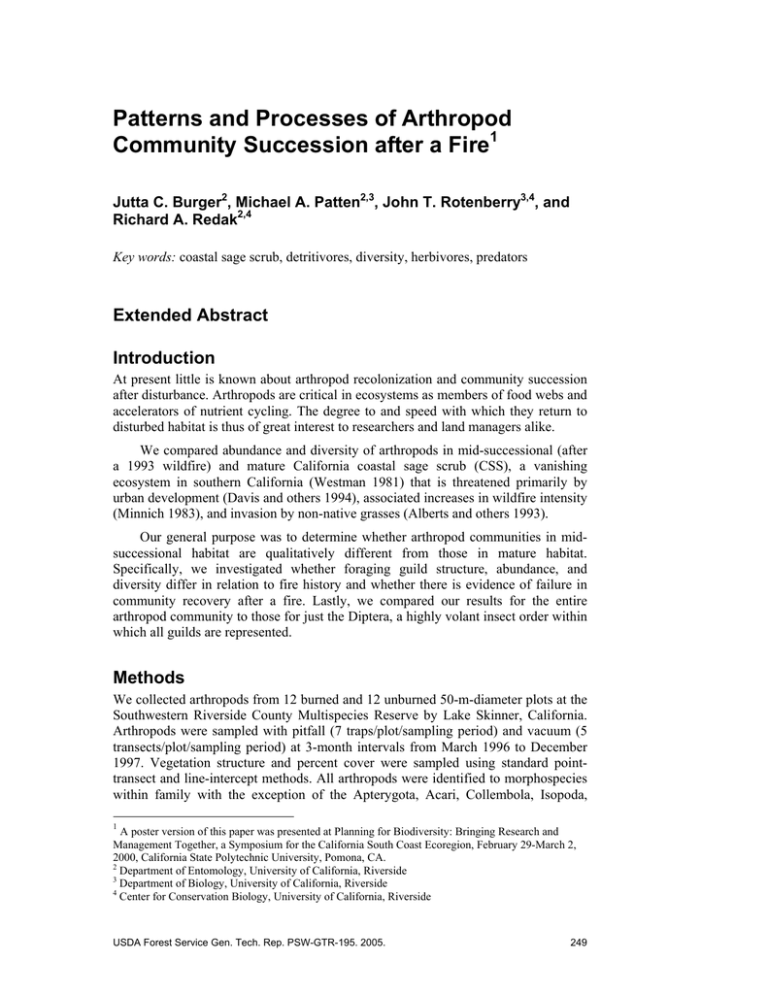
Patterns and Processes of Arthropod Community Succession after a Fire1 Jutta C. Burger2, Michael A. Patten2,3, John T. Rotenberry3,4, and Richard A. Redak2,4 Key words: coastal sage scrub, detritivores, diversity, herbivores, predators Extended Abstract Introduction At present little is known about arthropod recolonization and community succession after disturbance. Arthropods are critical in ecosystems as members of food webs and accelerators of nutrient cycling. The degree to and speed with which they return to disturbed habitat is thus of great interest to researchers and land managers alike. We compared abundance and diversity of arthropods in mid-successional (after a 1993 wildfire) and mature California coastal sage scrub (CSS), a vanishing ecosystem in southern California (Westman 1981) that is threatened primarily by urban development (Davis and others 1994), associated increases in wildfire intensity (Minnich 1983), and invasion by non-native grasses (Alberts and others 1993). Our general purpose was to determine whether arthropod communities in midsuccessional habitat are qualitatively different from those in mature habitat. Specifically, we investigated whether foraging guild structure, abundance, and diversity differ in relation to fire history and whether there is evidence of failure in community recovery after a fire. Lastly, we compared our results for the entire arthropod community to those for just the Diptera, a highly volant insect order within which all guilds are represented. Methods We collected arthropods from 12 burned and 12 unburned 50-m-diameter plots at the Southwestern Riverside County Multispecies Reserve by Lake Skinner, California. Arthropods were sampled with pitfall (7 traps/plot/sampling period) and vacuum (5 transects/plot/sampling period) at 3-month intervals from March 1996 to December 1997. Vegetation structure and percent cover were sampled using standard pointtransect and line-intercept methods. All arthropods were identified to morphospecies within family with the exception of the Apterygota, Acari, Collembola, Isopoda, 1 A poster version of this paper was presented at Planning for Biodiversity: Bringing Research and Management Together, a Symposium for the California South Coast Ecoregion, February 29-March 2, 2000, California State Polytechnic University, Pomona, CA. 2 Department of Entomology, University of California, Riverside 3 Department of Biology, University of California, Riverside 4 Center for Conservation Biology, University of California, Riverside USDA Forest Service Gen. Tech. Rep. PSW-GTR-195. 2005. 249 Poster Session—Arthropod Succession—Burger and others Psocoptera, Thysanoptera, Aphididoidea, and Coccoidea, which were counted. Each arthropod taxon was assigned to a foraging guild (detritivore, flower visitor, hematavore [blood feeder], herbivore, parasitoid, predator, or scavenger). Abundance and richness were compared between burned and unburned plots using t-tests with Dunn-Šidak corrections for multiple comparisons. Detrended correspondence analysis (DCA) was performed on abundance per site of all arthropods identified to morphospecies. Axis identity was determined by correlating plot scores on each axis (DC I and DC II) with vegetation variables. Families occurring only once were omitted from analysis. Results A total of 52,926 arthropods were collected with vacuum and pitfall samples. The distribution of arthropod guilds was more even in unburned than burned CSS. Proportionally more detritivores and herbivores were found in burned areas, and more flower visitors occurred in unburned sites. Overall, more arthropods were collected from burned sites, including significantly more detritivores and marginally more herbivores and predators. Abundance of arthropod orders followed a similar pattern to that of guilds, with orders associated with detritivore and herbivore feeding guilds tending to be more abundant in burned sites, but only Psocoptera (detritivores) were significantly more abundant in burned sites. Species richness per site of the six dominant arthropod orders (Hymenoptera, Araneae, Homoptera, Diptera, Coleoptera, Hemiptera) was remarkably similar across burned and unburned sites. Assemblages of families appeared to be qualitatively different among burned and unburned sites. Detrended correspondence analysis of family abundances produced a relatively short gradient (length = 1.14; 4.0 represents complete turnover). However, sites were separated according to fire history along DC I and along a grass cover gradient on DC II (fig. 1). Families positively associated with mature, unburned sites were Saturniidae (Lepidoptera), Corinnidae (Araneae), and Ptinidae (Coleoptera). Families associated with low grass cover were Kinnaridae (Homoptera), Cucujidae (Coleoptera), and Dermestidae (Coleoptera). All orders strongly associated with DCA axes I and II were relatively uncommon in our samples. Therefore, their associations independent of other orders are tenuous. Conclusions Results suggest that arthropod guilds are more evenly distributed in mature vs. midsuccessional coastal sage scrub. Mid-successional sites supported a higher abundance, but not a higher richness, of arthropods. Much of this difference in abundance was a result of higher numbers of detritivores in burned areas. Arthropod assemblages at the family level were associated with fire history and correlated with degree of grass cover, primarily as a result of the distribution pattern of relatively rare families (fig. 1). Grass invasion appeared to be affecting arthropod community composition in coastal sage. The guild structure of all arthropods in burned sites differed from that of just the Diptera (see Patten and others, this volume). Taxa that are less mobile than Diptera may be subject to vastly different conditions affecting recolonization. These include 250 USDA Forest Service Gen. Tech. Rep. PSW-GTR-195. 2005. Poster Session—Arthropod Succession—Burger and others purely local processes, such as the ability to survive and reestablish after a fire from populations on site or nearby rather than recolonizing solely via immigration. Acknowledgments M. Buffington, K. Campbell, T. Hosch, M. Misenhelter, E. Porter, T. Prentice, and C. Slotnick assisted in collecting arthropods in the field and identifying them in lab. M. Al-Siddiqi, E. Bonilla, N. Davis, M. Escobar, T. Gaines, S. Kensinger, and L. Trong assisted in sorting arthropods and data entry. J. Bethke provided technical assistance. C. Dunning provided helpful comments. This project was partially funded by a grant from Metropolitan Water District (agreement 4602). Figure 1—Detrended correspondence analysis of arthropod assemblages on burned and unburned sites. The dashed line is a heuristic to show the near complete simple separation of burned and unburned plots based on arthropod community composition. References Alberts, A.C.; Richman, A.D.; Tran, D.; Sauvajot, R.; McCalvin, C.; Bolger, D.T. 1993. Effects of habitat fragmentation on populations of native and exotic plants in southern California coastal scrub. In: Keeley, J.E., editor. Proceedings of the symposium on the interface between ecology and land development in California. Los Angeles, CA: Southern California Academy of Sciences; 103-110. Davis, F.W.; Stine, P.A.; Stoms, D.M.1994. Distribution and conservation status of coastal sage scrub in southwestern California. Journal of Vegetation Science 5: 743-756. Minnich, R. 1983. Fire mosaics in southern California and northern Baja California. Science 219: 1287-1294. Westman, W.E. 1981. Factors influencing the distribution of species of Californian coastal sage scrub. Ecology 62: 439-455. USDA Forest Service Gen. Tech. Rep. PSW-GTR-195. 2005. 251
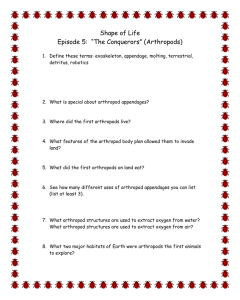
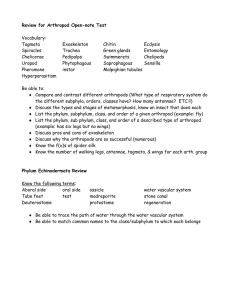
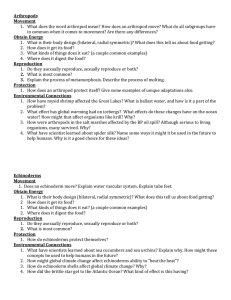
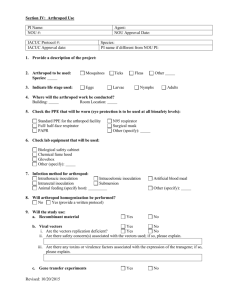
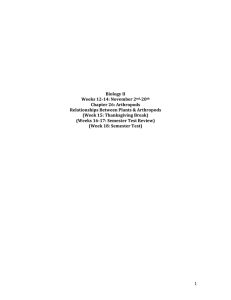
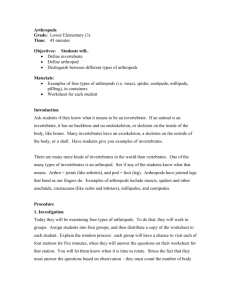

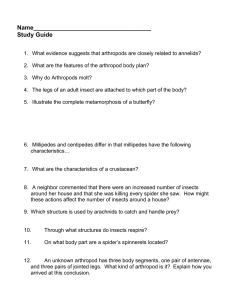
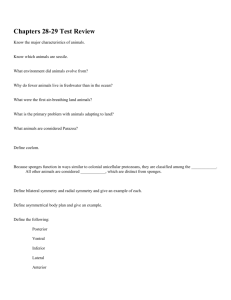
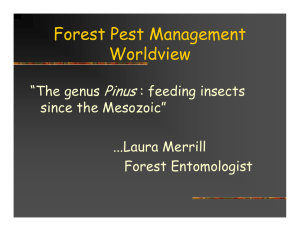
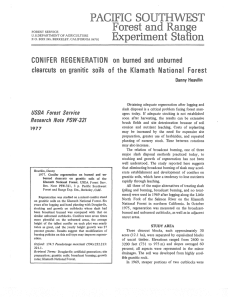
![Observations of Arthropod Populations Following the La Mesa Fire of 197']1 F.](http://s2.studylib.net/store/data/011866263_1-edbdb5f2e2ac67487d4079dde121a29f-300x300.png)